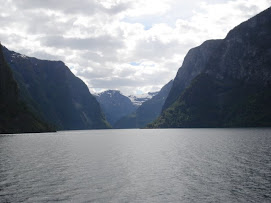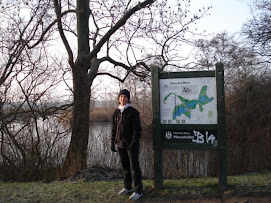
The weather has brought out a much happier demeanor in myself, my family and what seems like everyone else I come in contact with. The temperature has been above 50 degrees daily, and often in the 60's since the beginning of April. It's an unusual record for Denmark, but I'll take it. Finally, for the first time since moving here, I am warm. It's different that working up body heat on a bike, or wearing a ski coat with hat and gloves. The sun is penetrating and strong, the flowers are blooming on trees and people are showing skin on arms and legs!
When we arrived last August, the summer had already ended and we encountered rain and winds for the first couple of months, mixed in with a few nice days. I am told April to June are the nicest months, so we'll go out on a high note. Everything just seems to click better now. We're adjusting to most things beautifully and we encounter little stress. Life is good. I just looked at my calendar and May is our last full month living here. Late May and early June I'll have to start organizing our process of moving back to the U.S. but for now, I'm going go savor the freedom, the weather and new friends.
Last week I went on a Copenhagen City Walking Tour with a group of parents from the school. It was quite entertaining and full of city trivia.
For example, the old city streets used to be lower, but in the 17th century everyone threw their garbage on the streets and it piled up and squashed down and eventually the streets got higher. That is why we often have to walk a few steps down to door entrances!

City lights used to be lit by whale blubber! Can you imagine the smell?
And some the streets in the 16th - 18th centuries had open sewers. That plus the garbage made the city really a sight. The water was water was unfit to drink so people drank beer and aquavit (schnapps) because it was safe. Workplaces were mandated to give each employee a large bottle of beer and a small bottle of aquavit at their workstation to quench their thirst. How's that for work efficiency? That's why today still, drinking alcohol is second nature to most Danes. Many individuals drink beer like water, wine is always served with meals and teenagers and adults alike drink excessively. (that could also be why Danes drink the highest amount of coffee per capita than any other country!)

The great city of Copenhagen burned on many occasions, destroying some of the oldest buildings and churches. What's left today are only a handful from the 16th century, a little more from the 17th and quite a bit from the 18th century. According to our walking guide, these fires were caused by timbered buildings, candles and lamps and a strong wind. The constables in charge of unlocking the wells and assisting to put out the fires were usually too drunk to manage the job.

In the oldest church in the old city, St. Peter's, they used to bury the rich in the basement. It was quite a status thing and the more money you had, the closer you were buried to the altar. However, by the 18th century the smell of the graves became too offensive and they stopped the ritual. That's how they came up with the term "stinking rich"!

Bakeries didn't actually bake breads and desserts for the people, they were simply places with ovens where residents could bring their doughs for baking. This is the oldest bakery in Copenhagen. The pretzel and crown sign is a symbol for a trade union, that certifies a guaranteed level of products. Unfortunately for us, they don't serve pretzels...
Behind extremely nondescript doorways lie quiet, private courtyards. some are completely private and others are central areas for older apartments, cafes or other places. Walking in and out of them
 really gives one the feeling of the city being an intricate maze of cobblestone, alleys, and all the nooks and crannies of the old walled city. You can leave a very busy, noisy road and within minutes inside a courtyard have absolute quiet. It is here we were pointed out to the wall anchors. Since almost all building are made of brick or stone which expands and contracts with the heat and cold, wall anchors are built fro
really gives one the feeling of the city being an intricate maze of cobblestone, alleys, and all the nooks and crannies of the old walled city. You can leave a very busy, noisy road and within minutes inside a courtyard have absolute quiet. It is here we were pointed out to the wall anchors. Since almost all building are made of brick or stone which expands and contracts with the heat and cold, wall anchors are built fro m one end to the other to keep it from falling apart.
m one end to the other to keep it from falling apart.Lastly, commoners used to eat in Guest Houses or neighborhoods inns for their regular meals because most did not have kitchens or do their own cooking. These inns would have long wooden plank tables with bowl-like divets cut into each place-setting at the table. The propieter would serve the meal directly into the "bowl". The fork was attached to the table so it couldn't be stolen. People brought their own knives. So, the fork and bowl were used over and over by different people. With that and the open sewers, no potable drinking water, garbage on the streets, whale blubber for light and smoke from fires the city was a pretty nasty place. No wonder so many people died of disease by the age of 40.
There is much more to tell, but alas, I must return to the 21st century and get my children off to school and myself off to other adventures. Love and Light, Mary Jo
comments to: thecohen4dk@gmail.com




































































































































































No comments:
Post a Comment